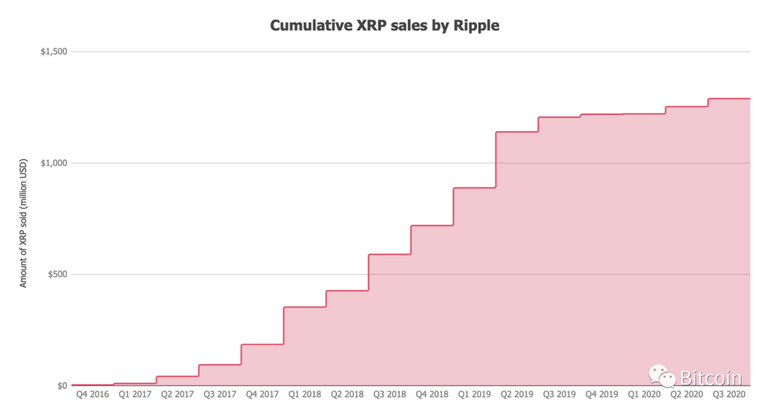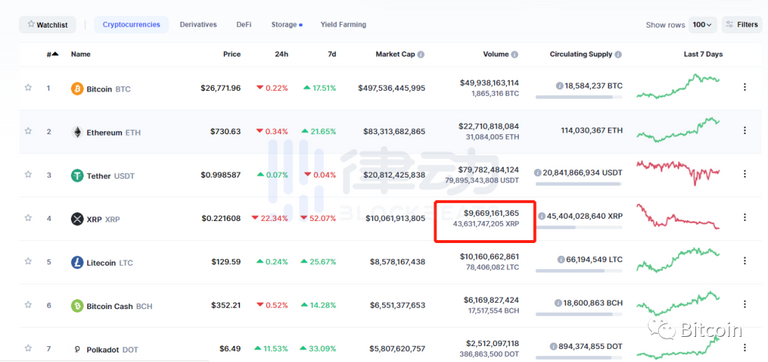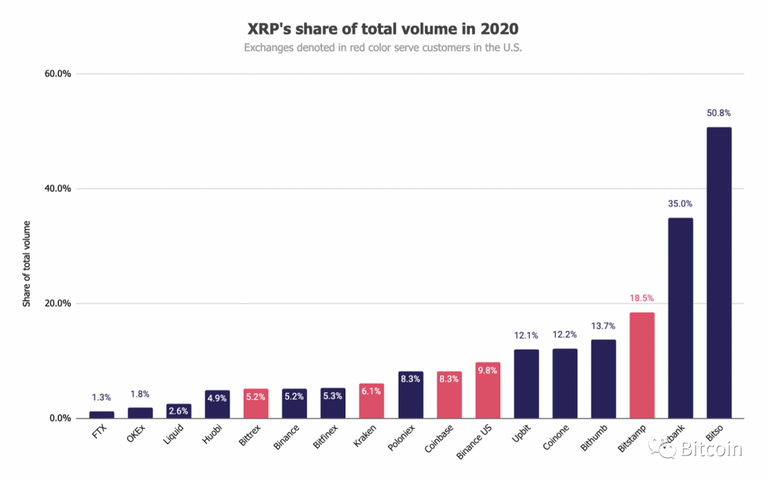.jpeg)
On December 29, the crypto trading platform Coinbase announced that it planned to completely stop XRP trading on January 20.
On December 29, the crypto trading platform Coinbase announced that it planned to completely stop XRP trading on January 20.
After nearly a week of fermentation, Coinbase delisted XRP and finally the dust settled. As a veteran cryptocurrency project ranked third in the world's total market value besides Tether, Ripple has almost launched most of the trading platforms, which means: delisting XRP is not only bad for project parties or investors, but for platforms that provide trading services, The same is true.
And if XRP is deemed non-compliant by the regulator, which platform will have the greatest impact on its trading volume?
Who are Ripple's XRP sold to?
According to statistics, since 2016, Ripple has sold $1.29 billion worth of XRP, of which 58% have been sold directly to cryptocurrency trading platforms (and then to retail investors), and the other 52% have been sold directly to retail investors through OTC. Agency sold.

The picture above shows the statistics of XRP sold by Ripple every year, source of picture: The Block
From statistical data, Ripple sold the largest number of XRP in the second quarter of 2019, and stopped selling when the market performed better. In fact, since the fourth quarter of 2019, Ripple has not sold tokens to trading platforms, but it is also likely that they have only been sold through institutions.

Image source: The Block
Handing over to the agency may be through the acquisition of the company. According to statistics, in June and November 2019, Ripple made a total of US$50 million in equity investment in MoneyGram in exchange for its shares and board seats. It is understood that Ripple currently holds about 9% of the latter's stock, but in November this year, Ripple sold about one-third.
According to MoneyGram’s earnings report, since 2019, Ripple has paid $52.3 million in XRP to it. The company classifies these expenditures as “market development expenses” rather than income.
Who "ditched" XRP
Since the SEC filed a lawsuit, as of December 29, several platforms and companies for US users have stopped XRP trading or related services. Trading platforms include Coinbase, Bitstamp, OSL, CrossTower, Beaxy and OKCoin; market makers/OTC merchants include Jump trading, Galaxy Digital and B2C2; asset management companies include Bitwise and 21 Shares; in addition, there is payment processing company Simplex.
Among them, the crypto asset management company Bitwise has liquidated the XRP position of its index fund. Before liquidation, XRP accounted for 3.8% of the fund. And 21Shares, a European crypto asset management company, also removed XRP from all its ETP products. The reason given is that they prohibit "any tokens used as securities and any tokens that may have liquidity problems." In December of this year, the acquisition of "XRP's largest market maker" B2C2 by a subsidiary of Japanese financial giant SBI also suspended the use of American users.
Why haven't other trading platforms taken any action yet? An important reason is of course the impact or impact on the business.
For the trading platform, owning the encrypted assets of the fans means the potential trading volume, which also means the subsequent transaction fees. According to CoinMarketCap data, even at the time of lawsuits and delisting of multiple trading platforms, the current daily trading volume of XRP is close to US$10 billion.

This data is second only to Bitcoin, Ethereum and Tether, comparable to Litecoin, and far surpassing projects such as Bitcoin Cash and Polkadot.
According to The Block analysis, the current transaction volume generated by XRP can account for 5-20% of the total transaction volume, and depending on each transaction platform, if it is completely delisted, it will at least reduce the total platform revenue by 5%. Taking Bitstamp, which focuses on the European market, as an example, XRP's trading volume in 2020 will account for 18.5% of the platform's total trading volume.

Image source: The Block
This explains why Bitstamp also suspends U.S. customers in the face of XRP with regulatory risks, rather than banning them all. In addition, XRP's trading volume accounted for a higher proportion of Japanese platform Bitbank and Mexican platform Bitso, at 35.0% and 50.8%, respectively. As an important partner of Ripple, these two platforms are currently on the sidelines.
It can also be seen from the above figure that the trading platforms we are more familiar with such as FTX, OKEx, Liquid, Huobi, Bittrex, Binance, Bitfinex, and Kraken are not the main battlefields of XRP trading. The trading volume accounts for 1-6 of its total trading volume. %.
If it is customary, Ripple’s lawsuit may drag on for months or even years. No one can be sure what kind of agreement the Ripple team will reach with the regulatory authorities, but no matter the outcome, the XRP market will be greatly affected. From XRP in the past 10 days, it has fallen from US$0.6 to US$0.22 on December 29.
Now that the compliant trading platform Coinbase has started, other players are likely to catch up: asset management companies may close positions, large market makers no longer provide liquidity, and crypto trading platforms are likely to follow suit. Suspending the provision of XRP transaction services to US users may make Ripple's situation increasingly difficult.
<p>Posted Using <a href=" <p>Posted Using <a href="https://leofinance.io/@chilok/if-ripple-really-loses-the-sec-lawsuit-which-trading-platform-will-be-most-affected">LeoFinance <sup>Beta